“Simplicity, poverty and the love of God and men are for St. Francis of Assisi dwelling, protective and saving envelope, the result of a path of true faith aimed at imitating Christ in every aspect, even in pain”: this is how the organizers of the exhibition inTORNO a Francesco (Assisi, Sala ex Pinacoteca, from November 14, 2021 to January 6, 2022, curated by Giulio Proietti Bocchini and Stefano Brufani) summarize the meaning of the exhibition, the first stage outside Tuscany of the Uffizi diffusi project. An exhibition starring one of the most important works of the thirteenth century, the panel with the Stigmata of St. Francis by the Master of the Cross 434 of the Uffizi(here an in-depth look at the iconography).
St. Francis experienced the message of Christ from his experience at San Damiano, when, according to the hagiographies, the crucified man ordered him to repair his house of Jesus that was falling into ruin-a message that was also manifested in the body with the limpression of the last seal, namely the stigmata. The exhibition has developed precisely around the theme of the union between St. Francis and the Savior, with a path aimed at investigating iconographically and stylistically the evolution of Franciscan figurative representations through a selection of works of art present in the territory. Is it therefore possible to learn about St. Francis through the works of art in the territory? The following is an itinerary with the selection proposed by curators Proietti Bocchini and Brufani, valid for discovering Assisi, its artistic treasures, as well as the life and works of St. Francis: in fact, the selection is also intended to be a “tool for reflection on the values that Francis with his life transmitted to posterity.”
The Crucifix preserved at the basilica of St. Clare is, according to legend, the cross that apostrophized St. Francis in the church of San Damiano. The wooden exemplar features Romanesque liconography of Christus triumphans, with the Ascension in the cymatium, mourners in the side panels and busts of saints in the suppedaneum. The work of an anonymous master from the mid-12th century, the panel celebrates Christ’s triumph over death, as shown by the Savior’s open eyes and indolent face, together with the decoration of the cymatium where He is reproduced as He ascends to heaven toward the outstretched hand of the Father ready to receive Him. Around, some angels hold a cross almost like a royal scepter and banner of victory, while at the bottom stands the phrase: IHS NAZARE REX IUDEORU (Jesus Nazarene King of the Jews).

The stupendous panel in the Museum of the Treasure of the Franciscan Basilica is a masterpiece of thirteenth-century painting, a work whose richness of invention and pictorial quality is so high that it was once attributed to Giunta Pisano, an attribution now ruled out in favor of an anonymous person conventionally identified as the “Master of the Treasure of St. Francis,” probably his follower. Characterized by a Byzantine style, the work possesses new features that highlight the artist’s great talent, such as the attention to the architectural backgrounds with wings inspired by the reality of the places in Assisi, and the expressive rendering of the characters, including Francis, depicted thin and emaciated, wearing all the signs of poverty.

The panel made of tempera, gold and stained glass is considered the oldest image of St. Francis preserved at the Portiuncula. In the center is the saint dressed in the habit of humility, standing while holding the Crucifix with his right hand and an open book with his left; evident are the signs of the miracle of the stigmata, including the wound in his side that bleeds emerging from the torn garment at one side. The painting, dated around 1255, is said by tradition to have been made from the wooden board that Francis used as a bed and over which he was placed after his death.

Behind the high altar of the Basilica of St. Clare is what undoubtedly represents the basilica’s most prestigious and oldest work: the Crucifix by the Master of St. Clare. It is a large cross modeled after the Christus patiens, commissioned before 1260 by Abbess Benedetta, portrayed in the suppedaneum on the left. Jesus’ recumbent head and arched body show the full weight of death, tenderly contemplated by the poverello dAssisi painted kneeling on a rock while clutching one of Christ’s feet with firm devotion.

The painting, a fragment of the scene with St. Francis receiving the stigmata, is part of the remains of the pictorial cycle painted along the nave of the lower basilica of St. Francis, which was partially destroyed a few decades after its completion by the opening of the arches leading to the chapels. This is the oldest decoration in the church, executed around 1260 by the so-called Master of St. Francis and depicting stories from the Life of Christ on one side and stories from the Life of St. Francis on the other. What remains of the depiction is the seraphim Christ without yet lattribution of the cross as he vibrates in the sky above the rock studded with plants and plant elements of La Verna.
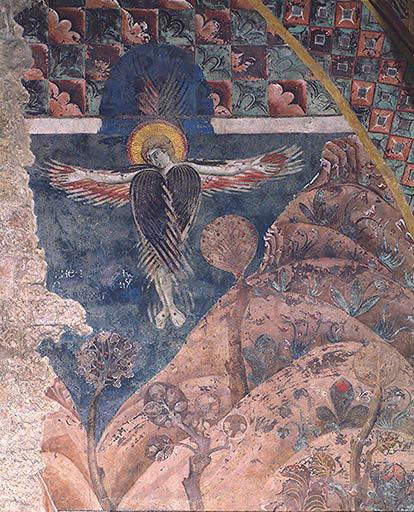
The Upper Basilica of St. Francis preserves an extraordinary collection of medieval stained-glass windows, the most complete in Italy despite extensive remodeling. The oldest are those of the apse, perhaps predating the basilica’s consecration (1253) and attributed to German craftsmen, followed by the lights of the left transept quadriphoras, possibly the work of French artists of an already Gothic culture, and the glass in the nave. The stained-glass window from which the detail with the stigmata comes is the one with Stories from the Life of St. Francis placed in the first window of the right wall of the nave, attributed to the Master of St. Francis and made in all probability after 1263, given the figurative language dependent on the Legenda Maior of St. Bonaventure of Bagnoregio.
 Master of St. Francis
Master of St. FrancisThe fresco (1285-1288) is located in the right transept of the Lower Basilica of St. Francis and is considered one of Cimabue’s greatest masterpieces. In the center is the Virgin and Child in Majesty, surrounded by angels and flanked by one of the earliest depictions by the poverello dAssisi, here a witness and conduit for the faithful of the sacred representation. St. Francis is barefoot, wearing a habit and carrying a book, the symbol of the Franciscan rule. He has a youthful appearance with a thick beard and cleric; his gaze is fixed toward the faithful to whom he clearly shows the signs of the stigmata. In the characterization of the saint, so sober and submissive, lies the great novelty introduced by Cimabue, who lays the foundations for the figurative revolution of the masters at the end of the century in a clear break with the Byzantine style in vogue until then.
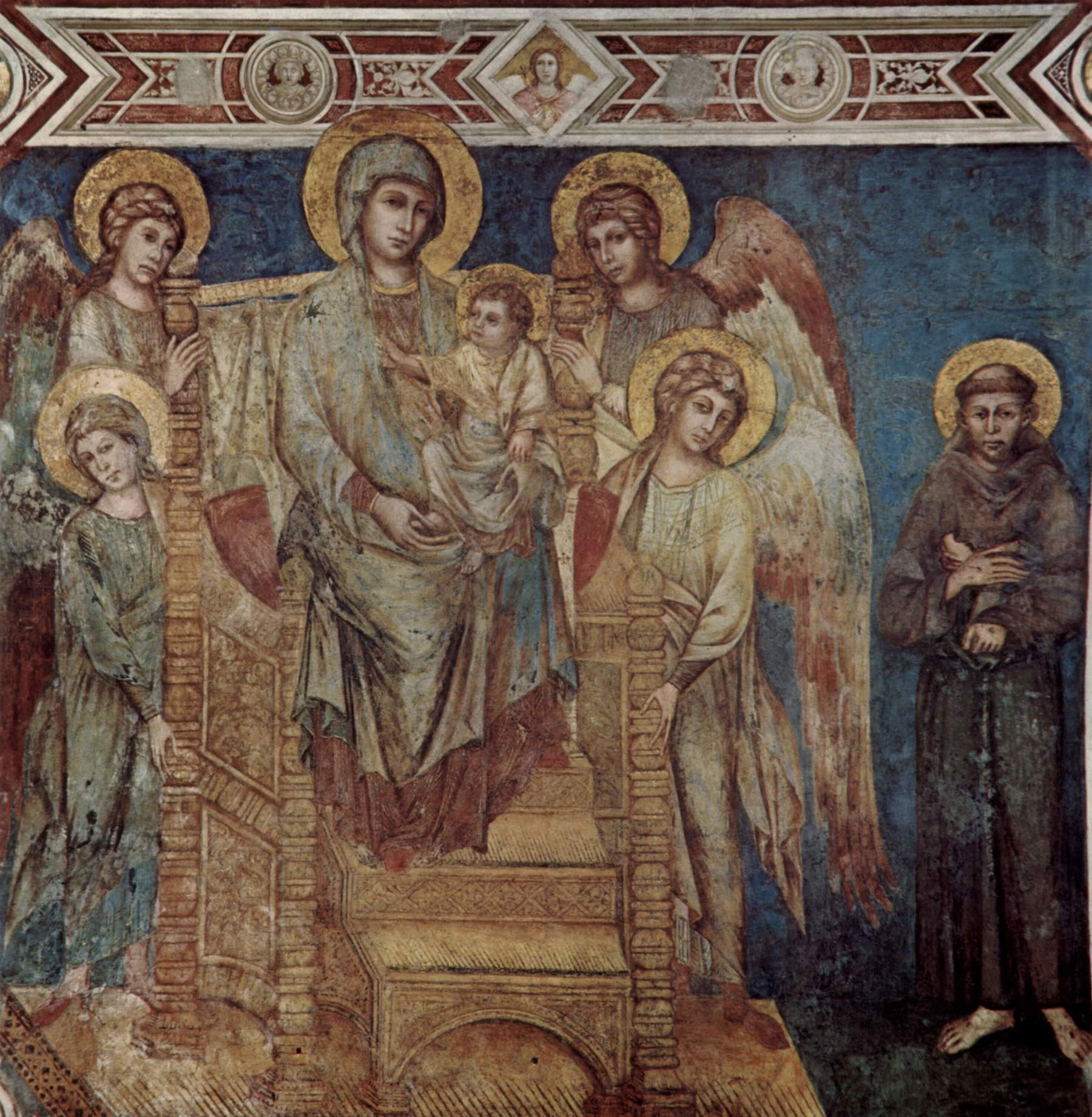
St. Francis Receives the Stigmata on La Verna is the nineteenth of twenty-eight stories from the life of St. Francis painted along the nave of the Upper Basilica of St. Francis, attributed to Giotto and inspired by the Legenda Maior by St. Bonaventure of Bagnoregio. This is the last scene of the saint’s earthly life, in which he is depicted as if he were an ancient hero, statuesquely immobile amidst the architecture of nature, waiting to receive the sacred stigmata from the seraphim Christ. The fresco presents all the characteristic elements of the master’s painting such as the use of chiaroscuro, perspective and a solid compositional structure. The result is extremely balanced and natural with Francis no longer depicted as a solitary ascetic, but as a man among men.
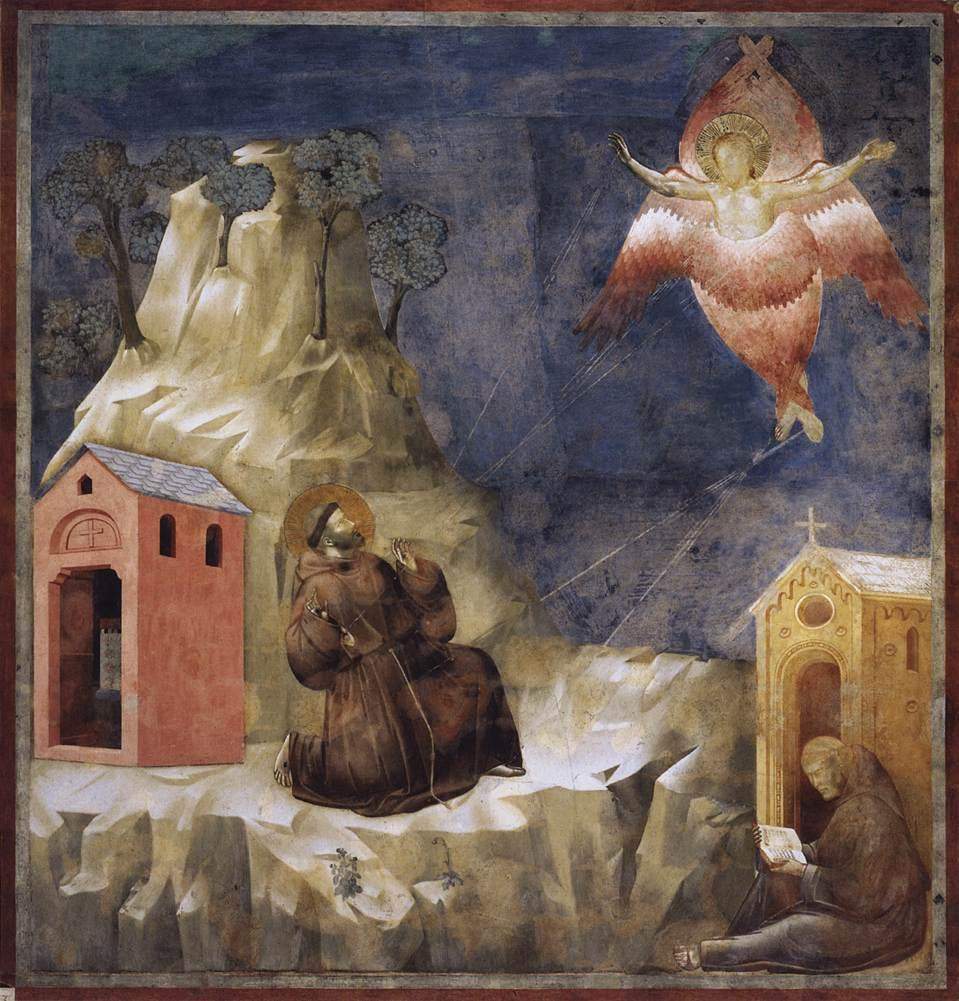
That of the Sienese painter is a fresco belonging to the cycle of stories about the Passion of Christ painted in the left arm of the transept of the Lower Basilica of St. Francis between 1315 and 1320. Drawing from the Legenda Maior of St. Bonaventure of Bagnoregio, Pietro Lorenzetti depicts Christ the seraphim attached to the cross imprinting the stigmata in the poor man’s body by means of gusts issuing from his wounds. Francis, kneeling on the rocky promontory of La Verna, arches backward, almost overwhelmed by the fortitude of that prodigy. The scene was intentionally placed by the artist immediately after the sequence of Christological images in order to establish a parallel between the life of the Savior and that of his most devoted follower, who first succeeded in conforming totally in him, receiving the stigmata and becoming alter Christus.
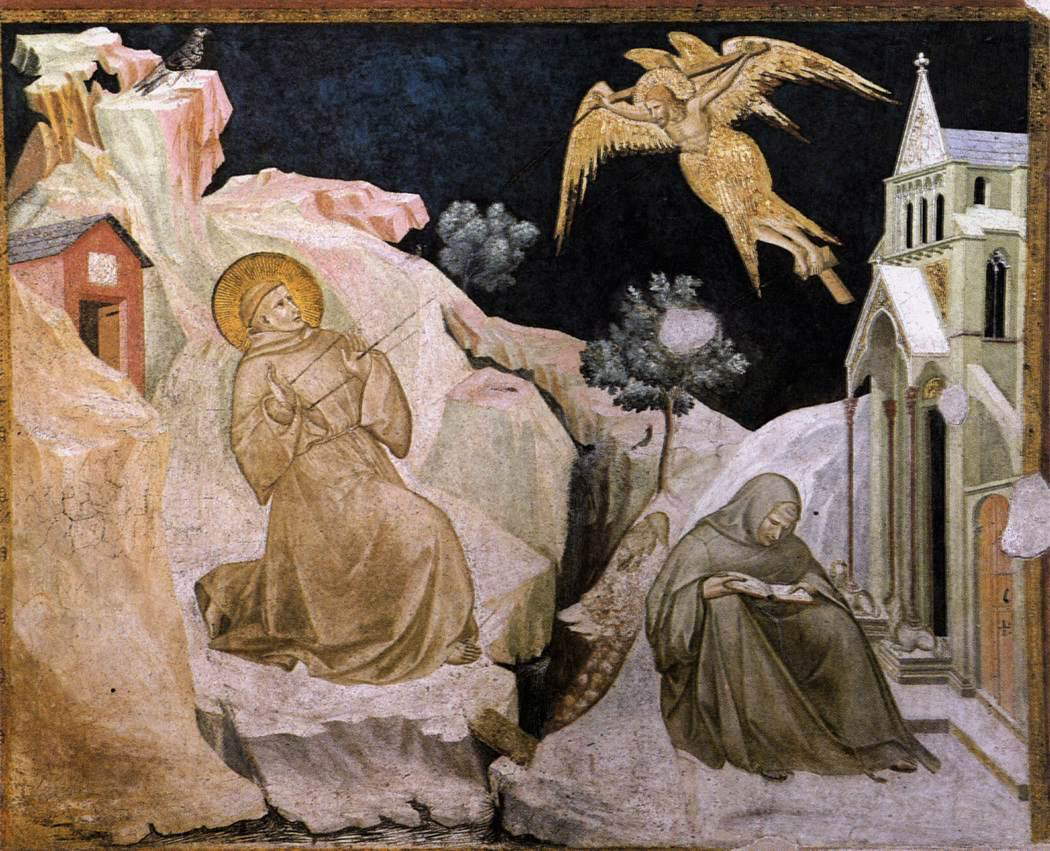
Now housed in the Diocesan Museum and Crypt of San Rufino in Assisi, this banner comes from the Confraternity of St. Francis or of the Stigmata and was made in 1378 by an anonymous follower of Pace di Bartolo, conventionally called the Master of St. Leonard. One side depicts St. Francis enthroned among musician angels, adored by disciples with a corpse in the center, while the other depicts a Crucifixion at the top and a scene with stigmata of St. Francis, left, and St. Leonard, right, at the bottom.

Originally placed in the chapel erected near the Porziuncola by Braccio Baglioni, lord of Perugia, Andrea della Robbia’s glazed terracotta dossal was made around 1475. Following the construction of the basilica and the consequent demolition of the Baglioni chapel, the work was placed on the altar dedicated to St. Joseph in the left transept (after 1652) where it remained until 1969 when, following the discovery of the remains of medieval factory foundations under the basilica’s chancel, the crypt was built. The altarpiece was finally transferred to the Portiuncula Museum in 1999. The work consists of three main images framed by an architrave supported by elegant pilasters. In the panel in the center is the Coronation ofthe Virgin, in the one on the right is the episode of St. Francis receiving the Stigmata at La Verna, and in the one on the left is St. Jerome penitent.
In the lower part is a predella, also tripartite, depicting the Annunciation, the Nativity and the Adoration of the Magi.
Painted on a commission from the city priors, the fresco depicting the Stigmata of St. Francis was created by Eusebio da San Giorgio in 1507 as an ornament to the cloister of the sanctuary of San Damiano, along with another of his paintings depicting the Annunciation. The work shows the artist’s good skills in assimilating the style of the major masters who flourished in Perugia, from the point of view of both drawing and color.
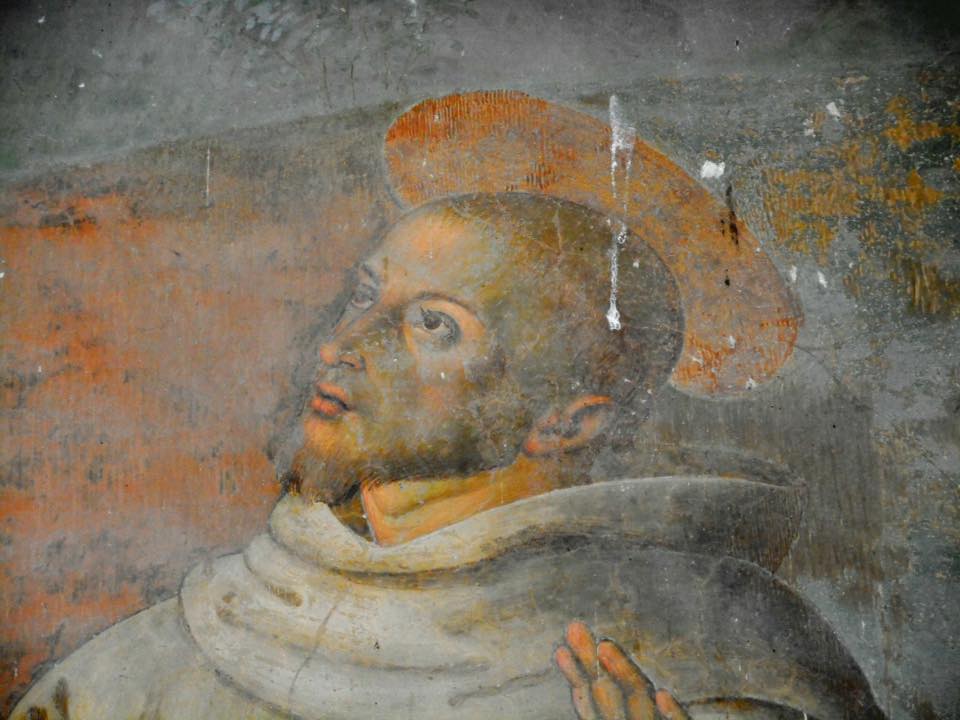
Merged into the Pinacoteca’s collections following the 1860 demanations, the oil on canvas by Dono Doni depicts the miracle of the stigmata and comes from the chapel of the Palazzo Comunale. The work is marked by a language in which elements of early 16th-century Tuscan and Roman culture coexist, organized according to an archaizing and traditionalist scheme. It is likely that the artist deliberately adopted this style in order to place himself on the margins of the issues of his own time, avoiding all decorative and profane excess, thus anticipating the painting of the Counter-Reformation.

The painting is located inside the Chapel of the Stigmata in the basilica of Santa Maria degli Angeli and is part of a series of paintings made by Giacomo Giorgetti together with Cesare Sermei in the 1630s. Within a skillful interplay of perspectives and foreshortening is depicted Saint Francis, on the bare rock with his arms outstretched, as he receives the sacred stigmata through the intercession of a seraphim. Below, in the half-light next to Brother Leo, a book and a skull are glimpsed, while on the other side a group of men react in dismay to the windfall. In the characters’ physiognomies, the volumes of drapery, and the compositional emphasis, one can detect a clear influence of Lanfranchian models, along with those of Antonio Circignani, known as the Pomarancio, whose presence in Assisi was full of consequences not only for Cesare Sermei, but also for younger artists such as Giorgetti himself and Girolamo Martelli.

On the facade of the Portiuncula, the ancient chapel associated with the memory of St. Francis of Assisi, now enclosed in the great basilica of Santa Maria degli Angeli, is a 19th-century fresco by Nazarene painter Friedrich Overbeck depicting the Institution of the Pardon of Assisi. The painting replaces a fresco by Girolamo Martelli superimposed on an earlier one by Niccolò di Liberatore known as the Pupil, mentioned by Vasari in his Lives. Lartista, through the recovery of Umbrian Renaissance models, repurposed the traditional iconography of the Pardon of Assisi with St. Francis kneeling facing the Virgin and Christ, seated above a cloud and surrounded by angels.
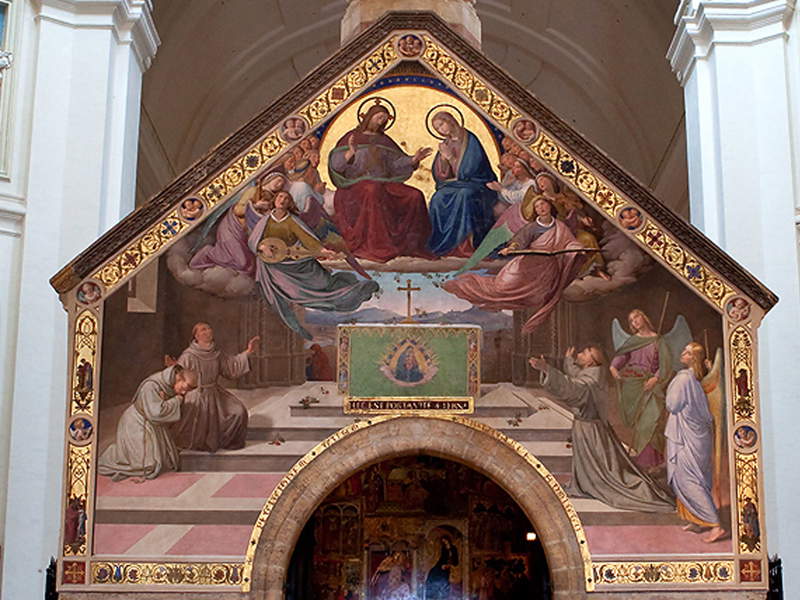
 |
| Assisi, an itinerary in 15 works to learn about St. Francis through art |
Warning: the translation into English of the original Italian article was created using automatic tools. We undertake to review all articles, but we do not guarantee the total absence of inaccuracies in the translation due to the program. You can find the original by clicking on the ITA button. If you find any mistake,please contact us.